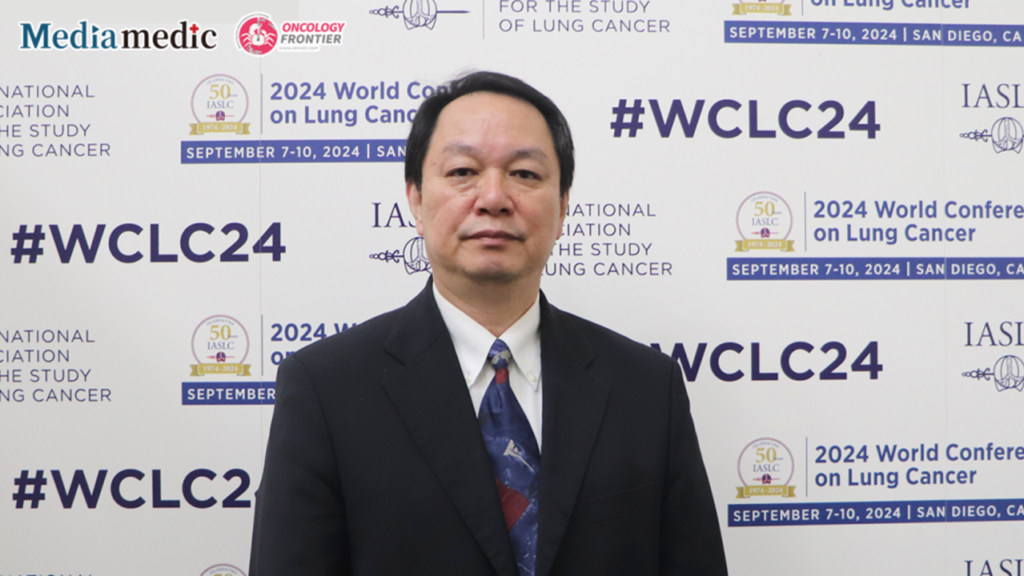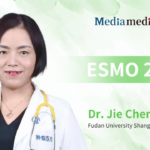
The 2024 World Conference on Lung Cancer (WCLC) was held in San Diego from September 7-10, featuring major studies from Chinese scholars. Oncology Frontier had the opportunity to interview Dr. Baohui Han from Shanghai Chest Hospital, inviting her to interpret the results of the DUBLIN-3 and DURABLE clinical trials.1. Oncology Frontier: The results of the phase III randomized DUBLIN-3 trial, in which you were the principal investigator, were presented at the 2024 WCLC. This study was previously presented at the 2021 ESMO and 2022 ASCO meetings. Could you provide some background on the DUBLIN-3 trial and its design?
Dr. Baohui Han: Conducting the phase III DUBLIN-3 clinical trial was extremely challenging. It began in 2015, with Academician Yan Sun leading the study alongside me and Professor Yuankai Shi. After eight years, the final analysis of DUBLIN-3 was presented at the WCLC session titled “OA08 – New Generation of Cytotoxic Agents.”
Over the past eight years, more than 900 patients were screened, with 559 patients with EGFR wild-type non-small cell lung cancer (NSCLC) who had progressed after platinum-based chemotherapy being randomly assigned to receive either docetaxel or docetaxel plus plinabulin. The final analysis yielded excellent results, with statistically significant improvements in objective response rate (ORR), progression-free survival (PFS), and overall survival (OS). DUBLIN-3 is one of the few clinical trials where docetaxel was successfully challenged in second-line treatment. The “OA08” session also featured reports from three other studies using ADCs and other new agents to challenge second-line docetaxel, but most of them reported negative outcomes, further highlighting the clinical significance of DUBLIN-3’s positive results.
Specifically, adding plinabulin to docetaxel significantly prolonged PFS, improving disease control duration. Most notably, this PFS benefit translated into an OS benefit, with a 18% reduction in the risk of death and an OS hazard ratio (HR) of 0.82. The OS benefit of plinabulin is due to its unique mechanism of action: it acts as a selective immune modulator by promoting the maturation of dendritic cells, enhancing antigen presentation, and activating antigen-specific T cells, thus boosting immune function. Additionally, plinabulin can induce macrophage polarization and increase the ratio of M1/M2 tumor-associated macrophages, further enhancing the anti-tumor activity of immune cells in the tumor microenvironment. Mechanistically, plinabulin may generate a tail-end effect in immunotherapy. Plinabulin significantly improved the 2-year and 3-year OS rates, with the 3-year OS rate doubling from 5.3% in the control group to 11.7% (P=0.0393), demonstrating a substantial improvement.
Moreover, plinabulin promotes the maturation of hematopoietic stem and progenitor cells (HSPCs), showing excellent clinical efficacy in protecting bone marrow function. In our study, 27.8% of patients in the docetaxel group experienced grade 4 neutropenia, whereas the addition of plinabulin reduced the rate of grade 4 neutropenia to 5.3%, about one-fifth of the control group’s rate. The combination of these two agents did not add toxicity but instead reduced the chemotherapy-related toxicity and protected neutrophils, demonstrating that plinabulin is a uniquely beneficial drug.
On the same day as our WCLC presentation, the results of the DUBLIN-3 trial were also published in The Lancet Respiratory Medicine. I encourage everyone to read the full article and provide us with feedback.
2. Oncology Frontier: Immunotherapy combined with chemotherapy has become the standard first-line treatment for extensive-stage small cell lung cancer (ES-SCLC). In your report at the 2024 WCLC, you presented data from the phase II DURABLE study (abstract MA17.07), comparing durvalumab plus anlotinib versus durvalumab alone as maintenance therapy for ES-SCLC. What are the implications of these findings for the use of immunotherapy combined with anti-angiogenic therapy in ES-SCLC maintenance treatment?
Dr. Baohui Han: Treatment for ES-SCLC has entered the era of immunotherapy combined with chemotherapy. However, the current three-drug regimens used in first-line therapy do not fully meet clinical needs. The question remains: can we add anti-angiogenic therapy to this regimen?
The phase III BEAT-SC study by Roche used first-line immunotherapy plus chemotherapy as the control group and explored the combination of atezolizumab with chemotherapy and bevacizumab in ES-SCLC, achieving positive PFS results. However, the PFS benefit did not translate into an OS advantage. Another phase III trial, ETER701, led by President Ying Cheng, combined bempegaldesleukin plus anlotinib with chemotherapy for first-line treatment in ES-SCLC, achieving both PFS and OS benefits. However, the four-drug regimen raised concerns about its higher cost and increased safety risks, with grade ≥3 toxicity reaching 94.3% and a high rate of treatment discontinuation, which may impact patient compliance.
DURABLE builds on the CASPIAN study, which established durvalumab combined with platinum-based chemotherapy as the standard of care for first-line treatment in ES-SCLC. DURABLE evaluated whether maintenance therapy after first-line durvalumab plus EP chemotherapy could further improve efficacy. In this study, after completing four cycles of EP chemotherapy and durvalumab, patients entered the maintenance phase, receiving either durvalumab alone or durvalumab plus anlotinib.
The results of DURABLE showed that compared to durvalumab alone, the combination of durvalumab plus anlotinib improved PFS from a median of 1.9 months to 5.4 months. When measured from the start of first-line treatment, PFS increased from 5.6 months to 9 months. Most encouragingly, the OS benefit was also clear, with median OS extending from 12.4 months to 17.4 months. When starting from first-line treatment, median OS increased from 15.4 months to 20.4 months, a 5-month improvement.
Regarding safety, the proportion of grade ≥3 treatment-emergent adverse events (TEAEs) in the durvalumab plus anlotinib group was 17.6%, with only 2.9% of patients discontinuing treatment due to TEAEs, a significant improvement over the ETER701 regimen. These results show that the DURABLE regimen offers a promising balance of efficacy and safety, setting a new record with a median OS surpassing 20 months.
We hope that the DURABLE study will add a new treatment option for clinical practice, helping address unmet clinical needs and advancing medical progress.
3. Oncology Frontier: The 2024 WCLC marks the first time in recent years that the conference has returned to North America, coinciding with the 50th anniversary of the International Association for the Study of Lung Cancer (IASLC). Could you share your impressions of the 2024 WCLC?
Dr. Baohui Han: I’m currently in San Diego attending the 25th WCLC. During the conference, a celebration was held for the 50th anniversary of IASLC, and I was honored to participate in this inspiring event. The celebration reflected on the progress IASLC has made over five decades, from its founding in 1974 to the present day, across two centuries. Every ten years has brought remarkable progress. Fifty years ago, lung cancer had a poor prognosis and lacked effective early screening methods. Today, innovations in diagnosis, targeted therapy, immunotherapy, multidisciplinary treatments, and minimally invasive surgery have dramatically improved early detection and survival rates for patients.
I remember 40 years ago, when I first started my career, lung cancer treatment in China was practically non-existent, with few available therapeutic options and a survival rate of less than one year for advanced lung cancer. Over the years, I have witnessed the evolution from chemotherapy to targeted therapy, anti-angiogenesis, and immunotherapy.
At the 2024 WCLC, I saw many clinical trial results involving immune bispecifics, ADCs, and novel immunotherapy agents that have the potential to provide high-quality clinical solutions. Every year, attending WCLC brings significant gains, offering insight into the latest international developments and future directions. This year, several groundbreaking studies from Chinese scholars were presented, including my own clinical research, which was well-received. Additionally, Professor Caicun Zhou from Tongji University-affiliated Shanghai Pulmonary Hospital was elected as IASLC President-Elect, reflecting the increasing recognition of Chinese scientists in the global fight against lung cancer and their growing voice on the international stage. We look forward to seeing Professor Zhou lead China and the world’s scholars to even greater success in his new role.
Dr. Baohui Han Shanghai Chest Hospital Leading Talent in Shanghai, Distinguished Academic Leader Executive Dean, China Lung Cancer Academy Chairperson, Precision Cancer Treatment Committee, China Initial Protection Fund Former Chairperson, CSCO Tumor Vascular Targeting Committee Vice Chairperson, Precision Cancer Treatment Committee, China Anti-Cancer Association Chairperson, Tumor Branch, Asia-Pacific Medical Biology and Immunology Society Deputy Editor, Chinese Journal of Oncology Vice Chairperson, Tumor Targeted Molecular Committee, Shanghai Medical Association (and upcoming Chairperson) Vice President, Respiratory Society, Shanghai Medical Association
Professor Han specializes in the diagnosis and multidisciplinary treatment of lung cancer, focusing on biological, immunological, and targeted therapies, as well as clinical research on new anti-cancer drugs. She has received numerous accolades, including the Chinese Medical Science and Technology Second Prize, the Eighth Chinese Respiratory Physician Award, and the Fourth Chinese Pharmaceutical Industry Innovation First Prize. She has also won several Shanghai Medical Science and Technology Awards (Second and Third Prizes).
Professor Han has authored over 300 articles in the field of lung cancer and has led and co-edited several key publications, including the Chinese Medical Association’s Lung Cancer Diagnosis and Treatment Guidelines, Biological and Immunological Targeted Therapy of Tumors, and Ultrasound Bronchoscopy Technology. She has also translated and edited Anti-Tumor Angiogenesis Treatment and contributed to more than ten medical reference books
References
1. Feinstein, B. Han, Y. Shi, et al. Plinabulin/Docetaxel vs. Docetaxel in 2L/3L NSCLC after Platinum Regimens (DUBLIN-3): A Phase 3 Randomized Controlled Trial. 2024 WCLC, abstract OA08.04.
2 B. Han, et al. Durvalumab Plus Anlotinib Versus Durvalumab as Maintenance Treatment in ES-SCLC (DURABLE): A Randomized, Phase 2 Trial. 2024 WCLC, abstract MA17.07.


